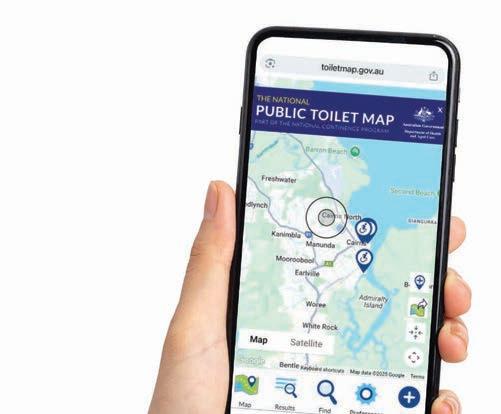
7 minute read
Incontinence: The invisible disability
Sharon experienced a life-changing birth injury which resulted in her living with undiagnosed faecal incontinence for a decade. This is her story.
In 1996 Sharon had a very quick birth with her first child who was a large 5.2kg baby. This resulted in a fourth degree tear (the most severe childbirth tear, involving the anal canal and the muscles around the anus that control when you do a poo), severe blood loss, and a life-long problem with faecal incontinence (loss of bowel control). No one explained the implications of her birth injury to her, offered any treatment, or told her about the possible problems she might have in the future.

Sharon's son was 18 months old the first time she lost control of her bowels. Over the next 8 years, she visited several different health professionals and was told she had IBS (irritable bowel syndrome). “I never felt wholly satisfied with the diagnosis of IBS, but went with it because that is what I was told,” Sharon explained.
The incontinence made me very anxious, I was always planning ahead to see where toilets were. I would get no warning that I was about to have an accident.
It wasn’t until her accidents became worse and more frequent that her husband went with her to the doctors to try and get answers. Luckily for Sharon, there was a locum doctor working who checked if she'd had a rectal exam. In the decade since childbirth, no one had thought to give her a physical exam. The doctor found she had no muscle on one side of her rectum due to her birth injury 10 years earlier and sent her to the specialist to confirm. Sharon had an anal sphincter repair surgery in 2010 to help her incontinence symptoms. She was told the repair would probably last 7-10 years.

“The anal sphincter repair surgery worked well for a while, but then I was starting to have more frequent accidents at work and in the car and getting very distressed by it. The loss of bowel control was so severe it was starting to impact work, socialising, holidays. I was always having to lie to people around me to cover it up. At this point I hadn’t told my kids, friends or work colleagues.”
By 2018, Sharon had to take time off sick from work because her body didn’t give her enough warning to get to the toilet and she was having frequent faecal accidents at the office which she found very distressing.
“The faecal incontinence ruled my whole life—from where I sat in a restaurant to choosing a seat on the plane for a work trip—I was constantly checking toilets and could never relax,” Sharon told Bridge.
She was offered a surgery to install a sacral nerve stimulator (SNS) which she decided to trial as opposed to having a stoma (a small opening in your stomach that allows poo to come out directly from the bowel into a bag). “The battery in my SNS will last about 7-10 years before it needs to be replaced. Since my surgery Australia has approved a rechargeable SNS. The sensation of the SNS is similar to a tens machine, but you can’t really feel it. You have a controller to turn it up or down as needed. I wear a MedicAlert 'medical device fitted' bracelet."
Find out more about a sacral nerve stimulators (SNS) on page 12 >>>
“After having the SNS fitted, I got my life back. Before the surgery the anxiety and despair got the better of me and I couldn’t use my common sense. Despite being a disability nurse and having been around people with incontinence for work, I didn’t feel that I could tell anyone what I was going through or talk to anyone about it," Sharon tells Bridge.
“Since having the SNS surgery I have been loads better at telling people about it. I was always worried about the reaction I would get from people if I told them, but actually I get a very good reaction from women especially."
Because my incontinence was caused by a functional problem, the SNS has provided excellent symptom relief. I have regained control and now have a lot more notice from my body that I need to get to the toilet. I still wear a pad because I have continuous small amounts of faeces leakage. I would say the SNS has cut my accidents by about 60-70%.
“I think people underestimate how mentally draining incontinence can be, from the minute you wake up to the minute you go to sleep. It impacts your work, social life, relationships. You have to always be prepared when you leave the house and have wipes, pads, spare clothes.”
Incontinence can happen to anyone and it doesn’t fit what people think having a disability should look like.
“I think it is hard for people who haven’t experienced it to know how truly debilitating it is. Because you walk around and look okay from the outside, people often give you a funny look if you come out of the disabled toilet after cleaning yourself up and changing your pad. It is one of the many invisible disabilities."
Four years ago, Sharon started a blog about her surgery journey which has now developed into an online support group for people to find out more about SNS surgery and living with faecal incontinence. Search Sacral Nerve Stimulator - My Journey on Facebook to join Sharon’s online support group.

Hidden Disability Sunflower

WHAT IS A HIDDEN DISABILITY?
In Australia, 1 in 5 people have some form of disability and 80-85% of these people have a disability that is hidden. That’s roughly 17% of the people around you who may have a non-visible disability that may impact their lives. 'Hidden disability' is a term interchangeable with non-obvious, invisible or non-visible, it simply means that the disability may not be apparent to an observer as there is no obvious indicator.
"Many of these disabilities come with challenges that, when met with barriers, prevent full access and inclusion for millions of Australians, including people with continence health conditions. The hidden disability sunflower was designed as a tool to signify that someone may need support, more time, help, patience or understanding because of their non-visible disability,” explains Justin Bruce, Director HD Sunflower Aus/NZ. "The aim is to shift the need to justify a disability by sharing private information, to start a conversation about the individual’s needs. We believe that if someone needs to be in close proximity to a bathroom or to access the nearest disabled toilet, they should be able to do so without explanation."
WHAT IS THE SUNFLOWER PROGRAM?
Living with a hidden disability can make daily life more demanding for many people, but it can be difficult for others to recognise, acknowledge or understand the challenges faced. Wearing the sunflower icon discreetly indicates to staff, colleagues and health professionals that the wearer (or support person with them) has a hidden disability and may need additional help or simply more time.
The hidden disability sunflower program has been in Australia for 5 years and you can buy your sunflower products online (hdsunflower.com/au), this may help you feel confident when using disabled bathrooms, asking where the nearest toilet is, or getting help at the airport with queuing.










